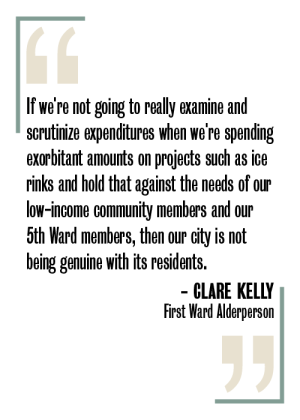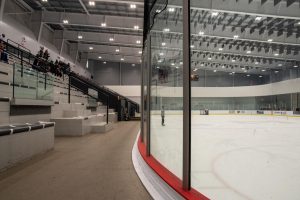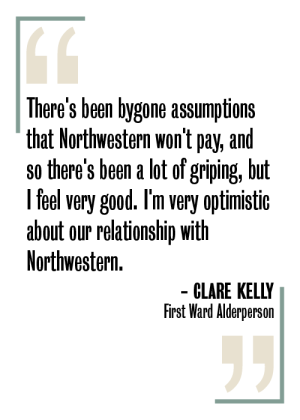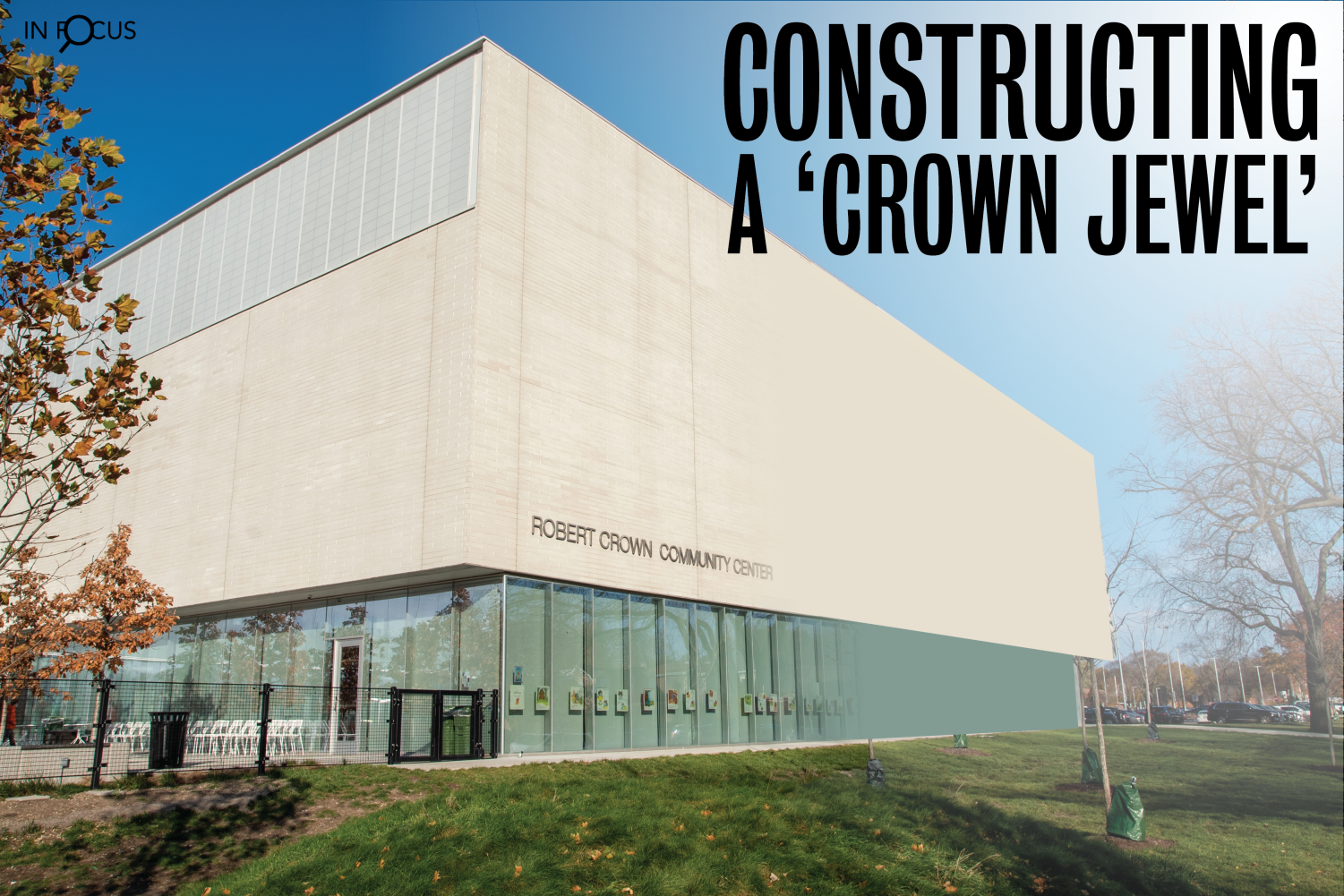In Focus: Nearly two years after its reopening, residents remain divided on the Robert Crown Community Center’s impact
November 22, 2021
Tucked into the bottom left corner of Evanston’s 4th Ward, a looming stone building with towering windows sprawls across 130,000 square feet. Behind its sliding glass doors, visitors can find two ice rinks, a gymnasium, an indoor track, art studios and a library. Outside its halls lie three turf fields — and a community divided over the facility’s impact.
This is the new Robert Crown Community Center, completed in early 2020 after years of planning. Meant to replace the city’s old community center, which was built almost half a century ago, the city initially billed the project as an investment into Evanston’s future.
But its execution didn’t go as smoothly as intended. As the project’s scope changed, budgets skyrocketed, worrying some community members. The center also opened its doors for the first time just weeks before the pandemic prompted global shutdowns, hampering resident access to the facility and upending the city’s budget.
The city decided to replace the facility after discussions about the state of the original community center came to a head. Daniel Stein, president of the nonprofit fundraising organization Friends of the Robert Crown Center, said residents insisted the city needed to improve the old center, which was plagued by structural issues and leaks.
“There was so much demand to change what we were doing — from an educational standpoint, from a recreational standpoint, from an equity standpoint,” Stein said. “People said, ‘We’re done with the old place. We had it for 43 years, but we literally loved it to death. It’s falling apart, we need to do something different.’”
Nearly two years after doors opened at Robert Crown, the annual price tag for the building’s maintenance and debt repayment is in flux as the pandemic alters the city budget. And long after the development plan was first approved, the center is still shrouded in conflict.
While the new Robert Crown will be a city fixture for decades to come, residents are still debating whether the final product is worth the price.
A costly history
The city started discussing renovations to the original center in 2000, more than 25 years after the facility was built. At multiple meetings over the years, community members described the original facility, which was built in 1974, as run-down and in need of modernization.
Early estimates for the project ranged from $18 million for building renovations to $30 million for an entire replacement with no expansions. But it was only in early 2017 that a city official first told The Daily the city planned to replace the facility altogether.
As the city got serious about the project, Friends of Robert Crown began soliciting private donations to go toward construction costs. The organization, which was founded by residents to separate fundraising efforts from city officials, initially pledged to shoulder $10 million of the center’s cost based on resident interest. That promise ultimately helped push the city to authorize a full replacement, former 4th Ward Ald. Donald Wilson told The Daily in 2019.

Since the first estimate, the price tag continued to grow as amenities were tacked on to the new facility’s plans. The addition of a library branch and turf fields drove the expected cost up by about $12.5 million. And inflation over the course of five years drove the valuation of the new Robert Crown even higher before city officials voted on the plan.
When City Council approved the contract for the new community center in February 2018, the price tag stood at $48.5 million — more than a 60% increase from the initial estimate for replacement. That summer, the city broke ground on the new facility.
But the project’s price continued to rise after its approval. Steel costs, construction contingencies and an ordinance requiring $400,000 worth of public art all pushed the new budget over $53 million.
Friends of Robert Crown ultimately agreed to fill the deficit, upping its planned contribution to $15 million. To date, the organization has raised $14.2 million in completed donations and pledged commitments to the center.
That figure includes a successful lobbying campaign that carved out $1.5 million in funding for the center from Gov. J.B. Pritzker’s Rebuild Illinois capital bill last year.
“This was something that was thought of and mindfully put together, so that we can make sure that all the folks in Evanston can take ownership in this place,” said Denise Barreto, a Friends of Robert Crown board member.
But the center’s projected costs haven’t matched up with the reality of the city budget. The city expected a yearly deficit of $500,000 in non-pandemic years for center staffing and maintenance — a number that quadrupled in the proposed 2022 budget.
The city can now expect to put $5 million a year toward the new Robert Crown for the next 20 years until its debts are paid off. That figure combines the center’s yearly staffing and maintenance costs with the $3 million Evanston will annually allocate to pay off the initial debt of the center’s construction. It’s also more than three times the projected expenditures for the Health & Human Services department in the proposed 2022 budget.
Ald. Clare Kelly (1st) said the city’s budget maps out its priorities each year. Before her election, Kelly organized for years against the cost of the current center. By committing to this level of funding for the new Robert Crown, she said city officials have prioritized the center over other forms of community investment, specifically those geared toward marginalized residents.
She said the scale of the project, especially with the inclusion of two NHL-sized ice rinks, caters to Northwestern. Evanston residents, she said, likely don’t need such expansive ice access.
The city’s hefty investments into the center also stand in stark contrast with the recently passed 5th Ward tax increment financing district, Kelly said. The TIF draws on property taxes to generate funding for reinvestment into the ward, rather than making 5th Ward investment a yearly budget line item — like the financing and debt repayment for Robert Crown — with sources of funding from outside the neighborhood, Kelly said.
By requiring a TIF for 5th Ward development but agreeing to fund the new Robert Crown with such a high price tag, Kelly said the city isn’t executing the equity goals it claims to prioritize.

“If we’re not going to really examine and scrutinize expenditures when we’re spending exorbitant amounts on projects such as ice rinks and hold that against the needs of our low-income community members and our 5th Ward members, then our city is not being genuine with its residents,” Kelly said. “We actually need a little truth and reconciliation with Robert Crown to see how that happened so that history doesn’t repeat itself.”
EPL begins a new chapter
After the city approved plans for the new community center, the expanded facilities were projected to result in about a 50% programming increase. But the center was already an integral part of the city, drawing patrons from across all nine wards.
Residents’ familiarity with the facility made it an ideal location for an expansion of Evanston Public Library, according to Karen Danczak Lyons, EPL’s executive director. She said she consistently pushed to include an EPL branch in the center when the city discussed any renovations or changes.
“Knowing the Robert Crown Community Center was historically the busiest venture, it seems like a really logical way to serve our families,” Danczak Lyons said. “There’s just so much potential there.”
Eventually, that push was successful. After opening in late February 2020, it became the library’s fourth branch at the time.
But library service in the city changed just months later, when EPL decided to shutter its Chicago Avenue/Main Street and North branches in August 2020. The move allowed the library to focus funding on the newly opened Robert Crown facility, which is closer to several historically underserved communities within the city and located near multiple public transit routes, Danczak Lyons said.
Evanston resident Linnea Latimer, who was born and raised in the city’s 5th Ward, grew up visiting multiple EPL locations. She said accessibility for marginalized residents has always been an issue.
Library resources are an opportunity for education and community support, she said, and it’s important to ensure these services are accessible to communities the city has harmed. Beyond literature, library-hosted programming can serve as an important resource for residents on topics like technology use or filing taxes, including through multilingual events.
Latimer said she’s thankful the city is investing in services for its residents and hopes the community will make the most of the space.

But she said the funding Robert Crown received also emphasizes the city’s priorities. That especially rings true when residents of her historically Black ward have consistently called for more resources, she said. Latimer has advocated for a library branch in the 5th Ward for years. Danczak Lyons said she supports the proposal, and is looking into location options.
“The city has spent so much money on that space, and I kind of feel like they left us all behind,” Latimer said. “It seemed like it was so easy for them to get the funding, but when you’re talking about funding from the city or from private donors or other organizations to put resources in our neighborhood, we have to jump through so many hoops.”
On thin ice
The library isn’t the only notable addition to the new center. The creation of another NHL-sized rink in the facility brought more possibilities for skating-related programming.
That expansion, in part, led to a deal. In exchange for ice time for its club synchronized skating and hockey teams through 2026, NU donated $1 million toward the project. The deal also provides free rink access and skate rentals during public skate for all NU students and staff with a Wildcard.
The University is also funding several open-skate times through the deal. Two of these events have already taken place, with two more scheduled for February and April.
This arrangement has benefitted both students who are involved with the synchronized skating or hockey teams and those who are learning to skate, according to Weinberg sophomore Alina Fernandez, secretary of NU’s club figure skating team.
Fernandez said the deal has removed the cost of rink rentals from members’ dues this year. Skating is an expensive sport, but eliminating the cost has made the team more financially accessible, she said.
The lifelong Evanston resident said the old center always felt like it was primarily an ice rink. After the new Robert Crown opened, she said she’s seen more fellow residents take advantage of features like the new library and revamped childcare center.
“During the school year specifically, it has been a lot more full,” Fernandez said. “A lot of the times, I’m at the rink while the public schools are ending, so a lot of kids after school come to the rink to wait for their parents or do some homework.”
NU’s executive director of neighborhood and community relations, Dave Davis, said he is looking to better the relationship between Evanston residents and the University. After finalizing the investment deal in April, he said the partnership provides an opportunity for NU to give back to the community.

The University is also funding educational programming at Robert Crown, Davis said. Though the content is still in development, Davis said it will be geared toward the city’s marginalized residents.
“The more that we could bring together University folks and Evanston residents, that helps to create an environment of trust and respect,” Davis said. “So we tried to replicate that over time.”
But the deal has stirred controversy. For some residents, it exemplifies an extractive relationship between the University and the city. They’ve said NU hasn’t contributed financially to the extent that it should.
NU’s charter prevents the city from taxing University land, preserving its status as a nonprofit whose facilities are used for educational purposes. That, however, has limited its financial contributions through property tax.
In 2015, NU launched the Good Neighbor Fund, an agreement to donate $1 million to the city annually for five years. But residents have said this doesn’t make up for the tax exemption, which could contribute much more annually to the city budget than the fund.
However, University President Morton Schapiro said NU adds value to the city in other ways, via construction projects, taxes on tickets for athletic events and building permits.
“Northwestern is a major contributor to the wellbeing of the city,” Schapiro told The Daily in October. “There’s a lot of things that are not financial that we do, and we can always do more.”
Kelly said the responsibility to hold the University accountable lies, in part, with City Council. After Evanston’s 81st council took to the dais in May, she said she hopes to see a shift in the city’s relationship with NU.
Previous councilmembers didn’t push the University to extend its financial contributions and strengthen its relationship with the city, she said. But she thinks some of her fellow councilmembers now want to tip that balance.

“We haven’t really had a voice on council that’s been willing to sit at the table or has at least taken the very serious initiative to sit down with Northwestern,” Kelly said. “There’s been bygone assumptions that Northwestern won’t pay, and so there’s been a lot of griping, but I feel very good. I’m very optimistic about our relationship with Northwestern.”
Charting community impact
Moving forward, Kelly said she is still concerned the center’s operating costs and debts will drain the city budget. For years, Evanston has priced out its low- and middle-income residents as property values and taxes have increased, she said. The new Robert Crown could add to that burden.
“I am concerned that it’s not going to play out for the residents who currently live there,” she said. “Whereas if we had created that in our budget, the same way we were prepared to build a $54 million, two-hockey-rink (recreation) center, we can better assure that.”
As the city continues to evaluate the effects of the pandemic on its residents, Latimer, the 5th Ward resident, said the new community center and library can serve as an example of the systemic issues marginalized community members still face.
Though the center is close to multiple routes of public transit, she said residents may still experience difficulties accessing the facility, including people who live in her ward. Costs associated with cars or public transportation may be barriers for some residents, since the facility is located more than a mile away from the 5th Ward, she said.
Stein, the Friends of Robert Crown president, said the pandemic has complicated efforts to analyze the impact of the facility on the community. But he said he’s anecdotally heard about the positive ways the new Robert Crown has influenced residents’ lives.
Looking long-term, Stein said the facility will hopefully benefit residents in a variety of ways. Throughout the proposal process, he said city officials and nonprofit members heard concerns from a wide range of community members. These discussions informed the plans for the center, he said, and have resulted in a facility that should address a wide range of needs.
Based on the current reception to the new Robert Crown, Stein said he is optimistic.
“We really wanted the new Robert Crown Community Center to have that same civic pride and that same accessibility,” Stein said. “If you don’t get people through the door, we’ve failed. And that’s why I know we’re succeeding.”
The city has yet to release any statistics about use of the new facility. As Evanston transitions out of its pandemic-era budget and restrictions, only time will reveal the impact of the new Robert Crown Community Center.
Email: [email protected]
Twitter: @jacobnfulton
Related stories:
— Robert Crown offers free ice skating for Northwestern students and faculty
— Northwestern to pay $1 million to city for use of Robert Crown
— City Council discusses hot-button issues in 2022 proposed budget

